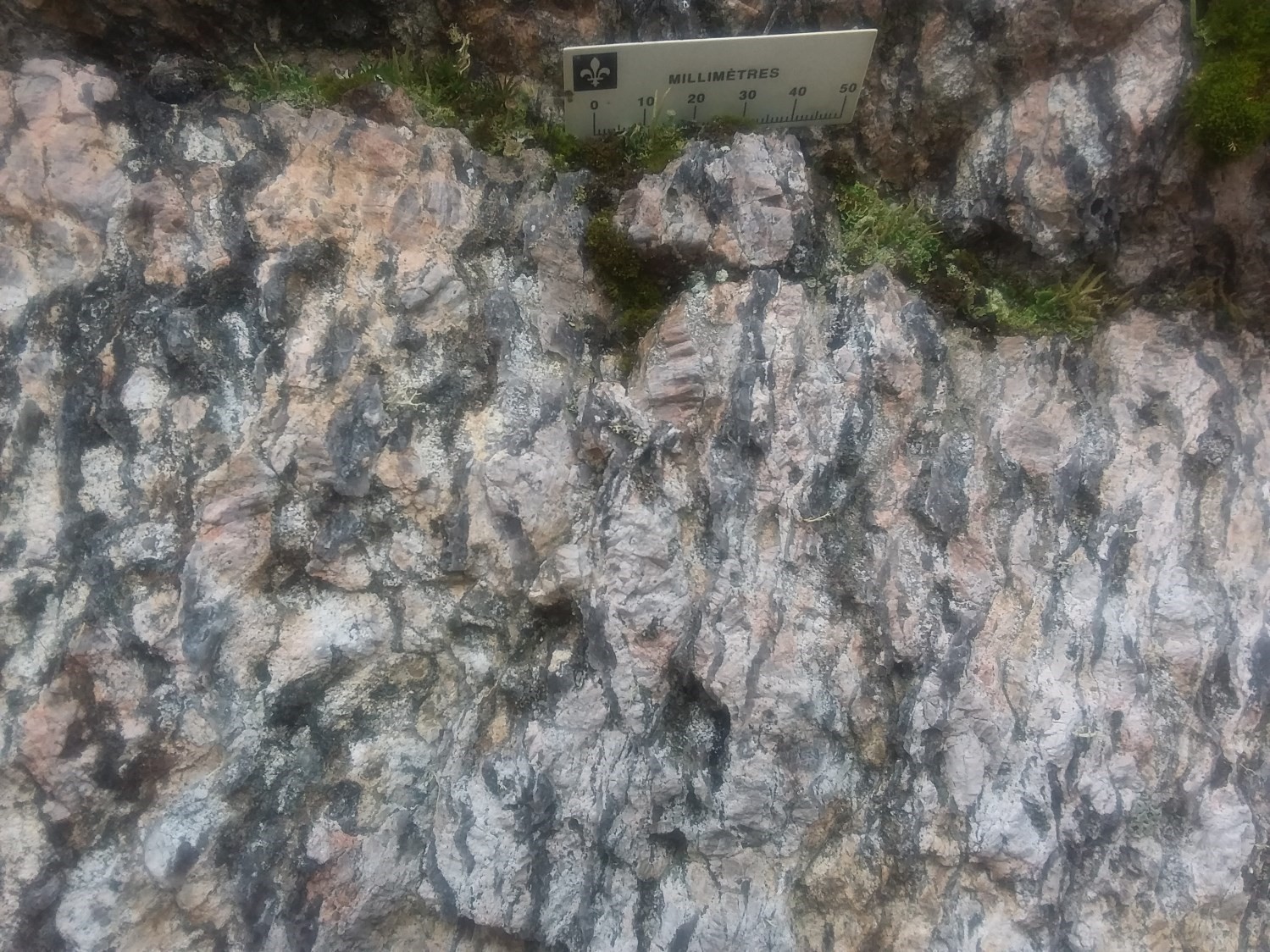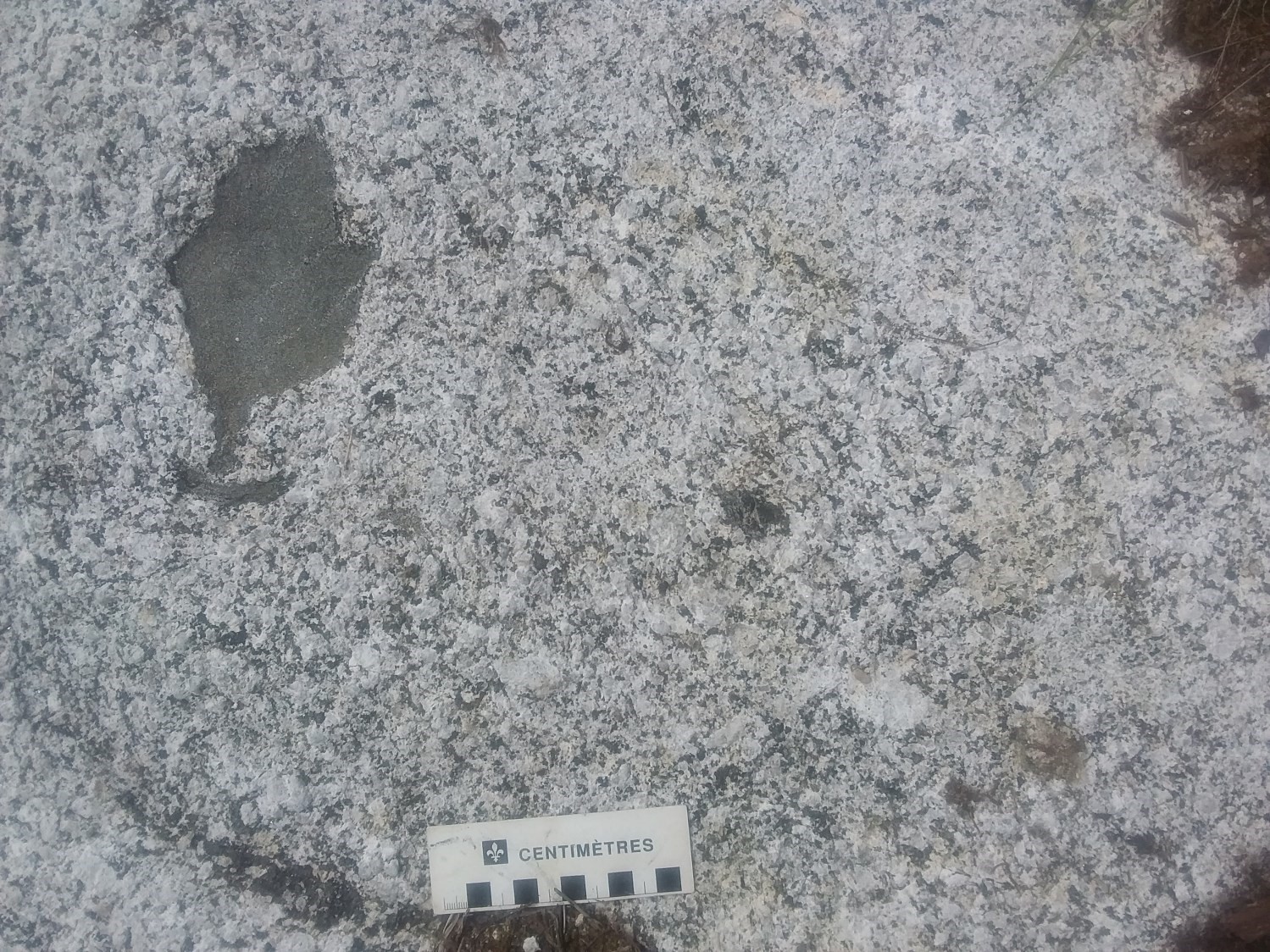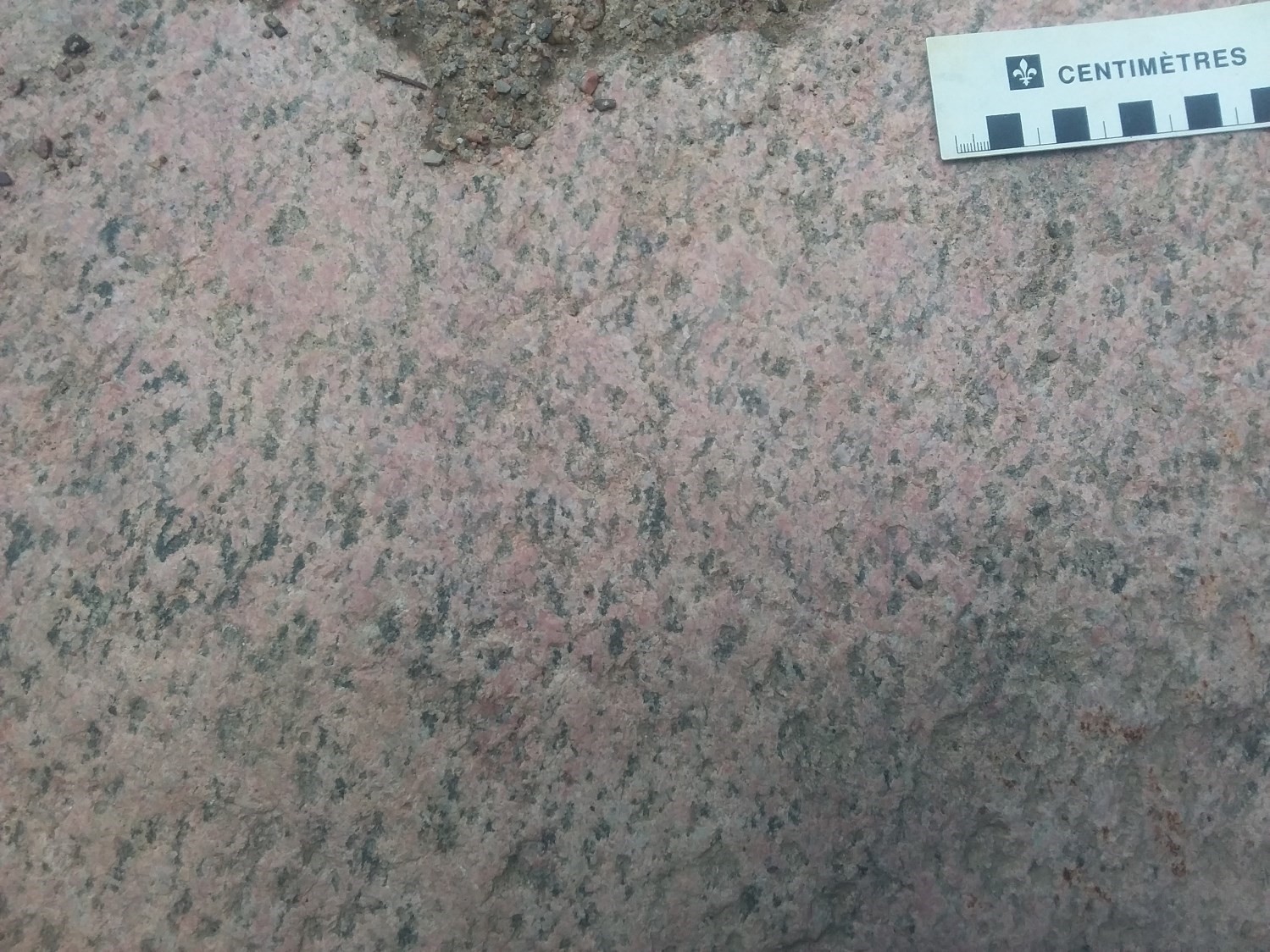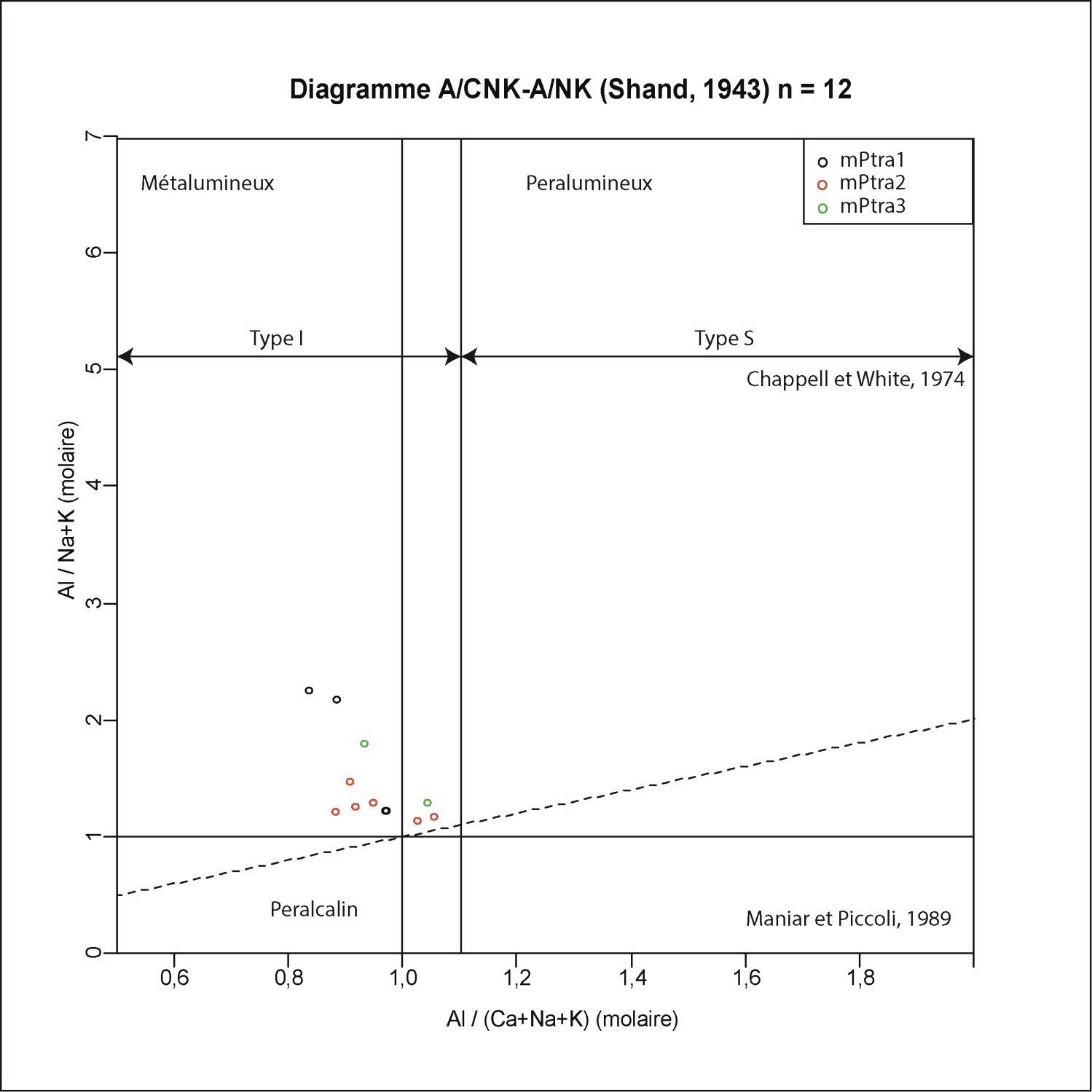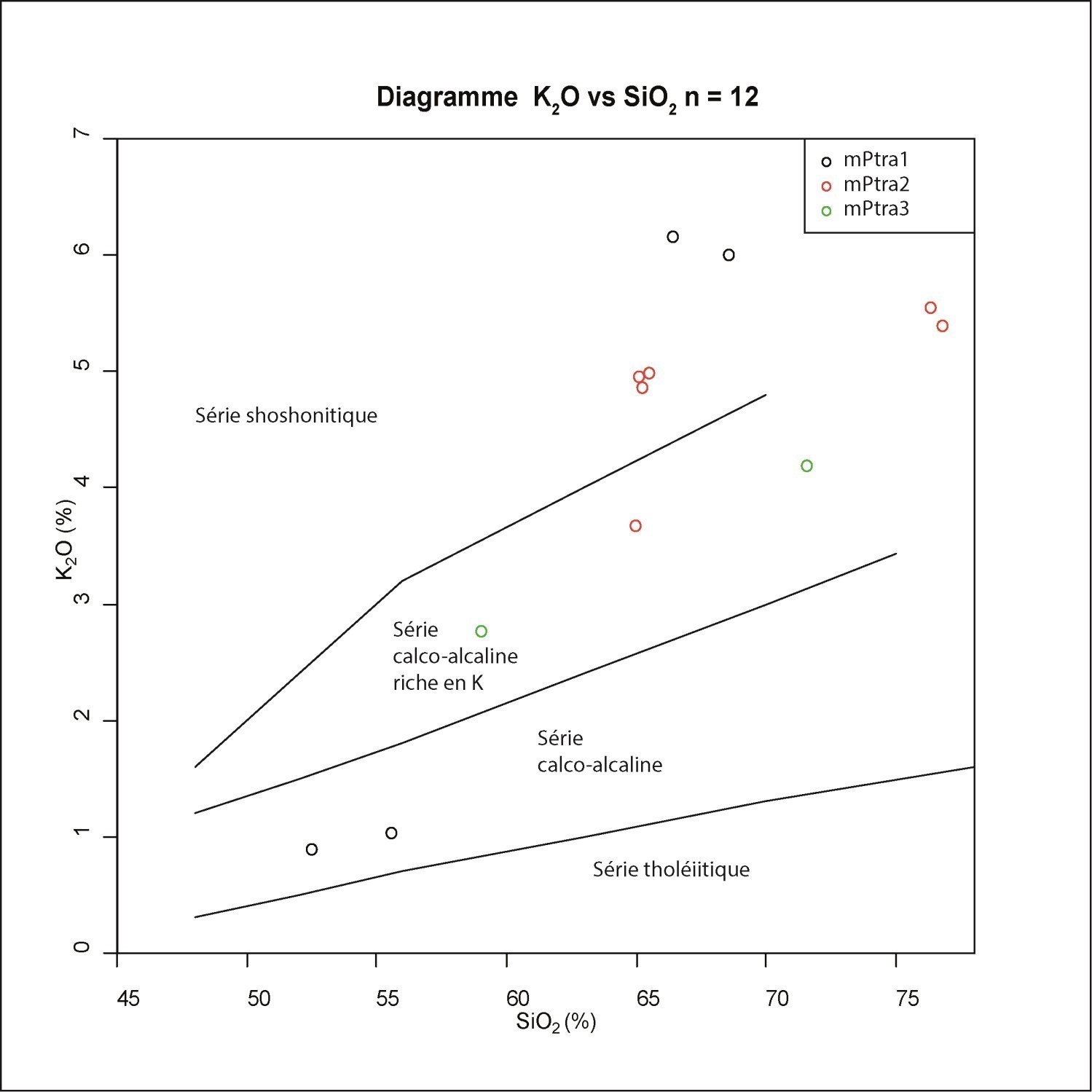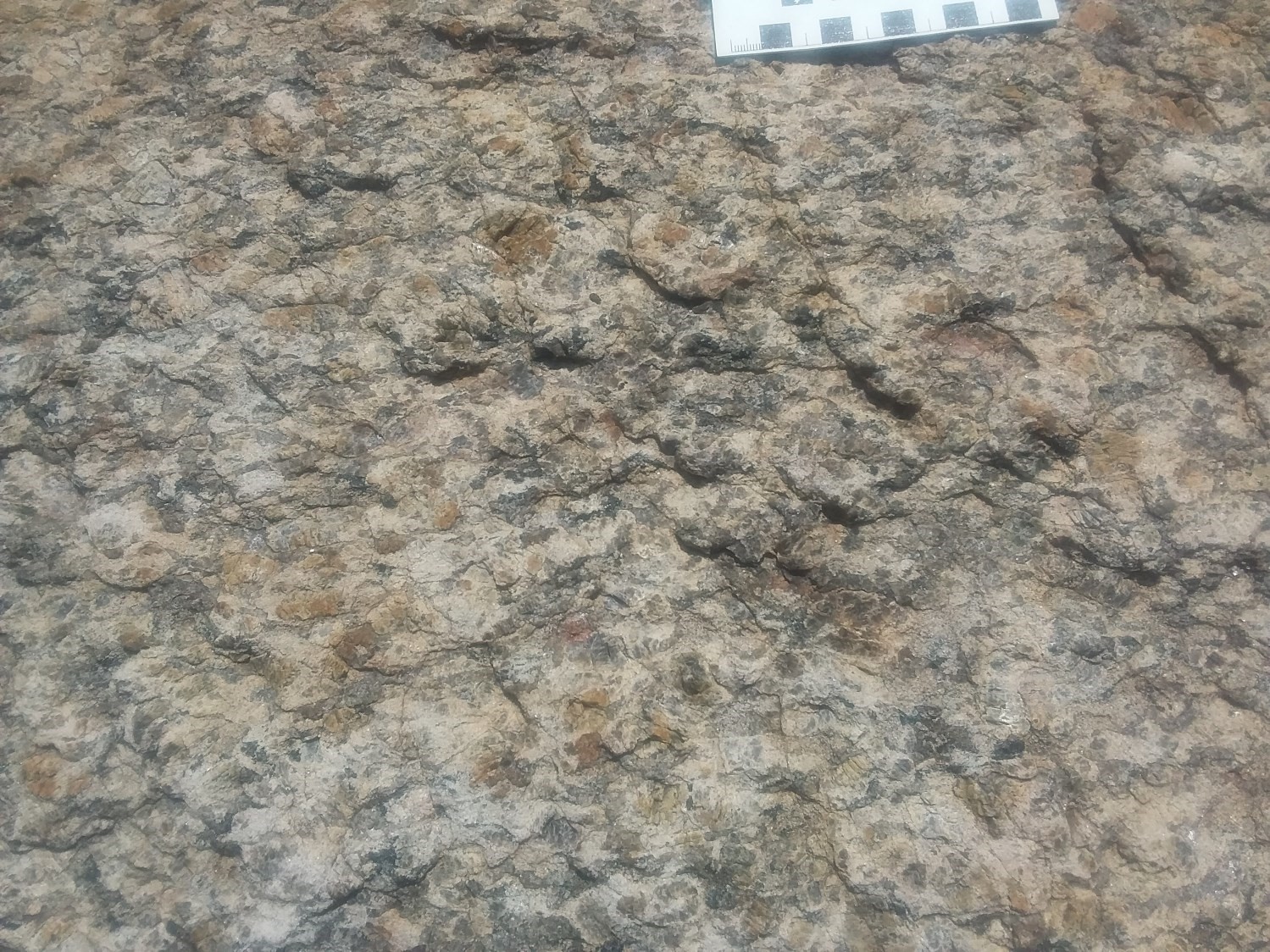
Last modified: 16 November 2016
Translation of original French
| Author: | Perreault, 1992 |
| Age: | Mesoproterozoic |
| Reference section: | Mangerite outcrop (17-AM-101) |
| Type area: | Haut-Saint-Maurice (NTS sheet 31P) |
| Geological province: | Grenville Province |
| Geological subdivision: | Allochton |
| Lithology: | Felsic to mafic intrusive rocks |
| Type: | Lithodemic |
| Rank: | Suite |
| Status: | Formal |
| Use: | Active |
None
Background
The Travers Suite is a unit introduced by Perreault (1992) during mapping of the Borgia Lake region (NTS sheet 31P16). It was defined as consisting of two felsic to mafic units: mPtra1 (gabbro, monzogabbro and mangerite) and mPtra2 (granite). During the summer 2017 mapping work, Moukhsil and Côté (2018) added lithologies to the previous two units and identified a third subdivision. A fourth informal unit was added during the work of Moukhsil and Daoudene (2019) in the Commissaire Lake region (sheets 32A01 and 32A08). The following description is of Moukhsil and Côté (2018) and Moukhsil and Daoudene (2019).
Description
Travers Suite 1 (mPtra1): Gabbronorite, Hypersthene Diorite, Mangerite and Minor Amounts of K-Feldspar-Hypersthene Granite
Gabbronorite is fine grained and composed of orthopyroxene, clinopyroxene, plagioclase, biotite, titanite, zircon and trace quartz. Orthopyroxene is highly altered and has a rim composed of clinopyroxene, plagioclase and quartz (likely resulting from orthopyroxene retrograde metamorphism). Biotite is tabular and subhedral, either disseminated or as an alteration product of other ferromagnesian minerals. Hypersthene diorite is medium grained, porphyritic (plagioclase and local orthopyroxene phenocrystals) and foliated. It also contains biotite, amphibole, magnetite and trace K-feldspar. Mangerite is mainly composed of orthopyroxene, plagioclase, K-feldspar, quartz and traces of zircon and opaque minerals. K-feldspar-hypersthene granite is also composed of amphibole, clinopyroxene, plagioclase, quartz, titanite, gahnite and zircon. This rock is coarse grained, porphyritic and locally exhibits strong deformation visible by cataclastic or mortar texture. K-feldspar is antiperthitic, whereas plagioclase is perthitic with undulatory extinction and weak sericitization. Gahnite and titanite are located on the edges of opaque minerals.
Travers Suite 2 (mPtra2): Mangerite, Syenite, Orthopyroxene Syenite, Minor Amounts of Syenogranite and Granite
Mangerite is composed of orthopyroxene, plagioclase, K-feldspar, apatite, quartz, zircon and opaque minerals. Plagioclase is perthitic. Orthopyroxene is urilitized, biotitized and has undergone severe hydrothermal alteration, giving it a brownish colour under the microscope (in natural light). Ferromagnesian minerals are concentrated in clusters. In these, you can see inclusions of opaque minerals, zircon and apatite. Biotite appears to be an alteration product of amphibole. Syenite is composed of amphibole, biotite, K-feldspar, plagioclase, clinopyroxene, zircon, titanite and opaque minerals. This rock is porphyritic due to the presence of antiperthitic K-feldspar and has mortar texture. Titanite is located on the edge of opaque minerals. Finally, apatite is either disseminated or as inclusions in ferromagnesian minerals. K-feldspar granite also contains plagioclase, quartz, opaque minerals, zircon and allanite. This medium-grained rock has a small percentage of ferromagnesian minerals. Quartz locally shows myrmekitic texture. Allanite is scarce, occurring as small subcircular crystals surrounded by concentric fractures.
Travers Suite 3 (mPtra3): Granite, Syenogranite, Minor Amounts of Gabbronorite, Monzonite and Quartz Syenite
Granite and syenogranite are fine to medium grained and are composed of K-feldspar, plagioclase, quartz, biotite, clinopyroxene, zircon, apatite and opaque minerals. Biotite is found in large poikilitic tabular crystals containing quartz, or in small alteration crystals that affect clinopyroxene parallel to cleavage. K-feldspar is antiperthitic and quartz is locally myrmekitic. Granite is K-feldspar porphyritic. Rocks in this unit are heavily deformed in places, giving them a cataclastic texture. In addition, in deformation zones, plagioclase is highly sericitized and white mica (muscovite) crystals are observed. Gabbronorite has the same composition as that of unit mPtra2. Quarz syenite is medium grained and contains amphibole, microcline, sodic plagioclase and trace orthopyroxene. The unit contains centimetric to metric paragneiss enclaves.
Travers Suite 4 (mPtra4): Syenite, Orthopyroxene Syenite, Quartz Syenite, Akali Feldspar Granite, Quartz Monzonite, Syenogranite
Unit mPtra4 consists mainly of pinkish syenitic facies marked by a percentage variation in quartz, biotite, amphibole and especially orthopyroxene. These syenitic facies are generally k-feldspar porphyritic. The latter is perthitic and locally sericitized. There are carbonates in places. Alkali feldspar granite and quartz monzonite are generally medium grained and composed of biotite, hornblende, K-feldspar and plagioclase. Orthopyroxene, apatite, zircon and opaque minerals are ancessory minerals. Locally, this unit also includes salmon-pink porphyritic biotite-hornblende-K-feldspar-plagioclase syenogranite.
From a geochemical perspective, the Travers Suite consists of mafic to felsic rocks with SiO2 contents ranging from 52.4 to 76.69% and K2O contents from 0.9 to 5.39%. The majority of rocks in this suite are metaluminous (Maniar and Piccoli, 1989) and type I (igneous origin; Chappell and White, 1974). In addition, mafic rocks are of calc-alkaline affinity, and intermediate and felsic rocks are calc-alkaline (potassium rich) to shoshonitic (Peccerillo and Taylor, 1976).
Thickness and distribution
The Travers Suite consists of two plutons located in the northeast portion of sheet 31P16, which likely extend into adjcacent sheets. The fourth unit (mPtra4) predominantly occurs as more or less thick dykes roughly N-S oriented. It intrudes into other units of the same suite.
Dating
| Isotopic System | Mineral | Crystallization Age (Ma) | (+) | (-) | Reference(s) |
| U-Pb | Zircon | 1076,2 | 8,4 | 8,4 | Papapavlou, et al., 2018 |
Stratigraphic Relationship(s)
The Travers Suite intrudes into the La Bostonnais Complex and contains klippes of the Montauban Group.
Paleontology
Does not apply.
References
| Author(s) | Title | Year of Publication | Hyperlink (EXAMINE or Other) |
|---|---|---|---|
| MOUKHSIL, A. – CÔTÉ, G. | Géologie de la région du lac Borgia, Province de Grenville, nord de La Tuque, régions de la Mauricie et du Saguenay – Lac-Saint-Jean, Québec, Canada. Ministère de l’Énergie et des Ressources naturelles, Québec. | 2018 | Bulletin géologiQUE |
| MOUKHSIL, A. – DAOUDENE, Y. | Géologie de la région du lac des Commissaires, Province de Grenville, région du Lac-Saint-Jean, Québec, Canada. Ministère de l’Énergie et des Ressources naturelles, Québec. | 2019 | Bulletin géologiQUE |
| PERREAULT, S. | Géologie du Grand lac Bostonnais. Ministère des Ressources naturelles et de la Faune, Québec; CG SIGÉOM31P, 1 map. | 1992 | CG SIGEOM31P |
| PAPAPAVLOU, K.– MOUKHSIL, A. – COTÉ, G. – POIRIER, A. | U-Pb Geochronology of Zircon by LA-ICPMS in samples from the Grenville Province (La Tuque Area, Quebec). Ministère de l’Énergie et des Ressources naturelles, Québec. | 2018 | MB 2018-35 |


